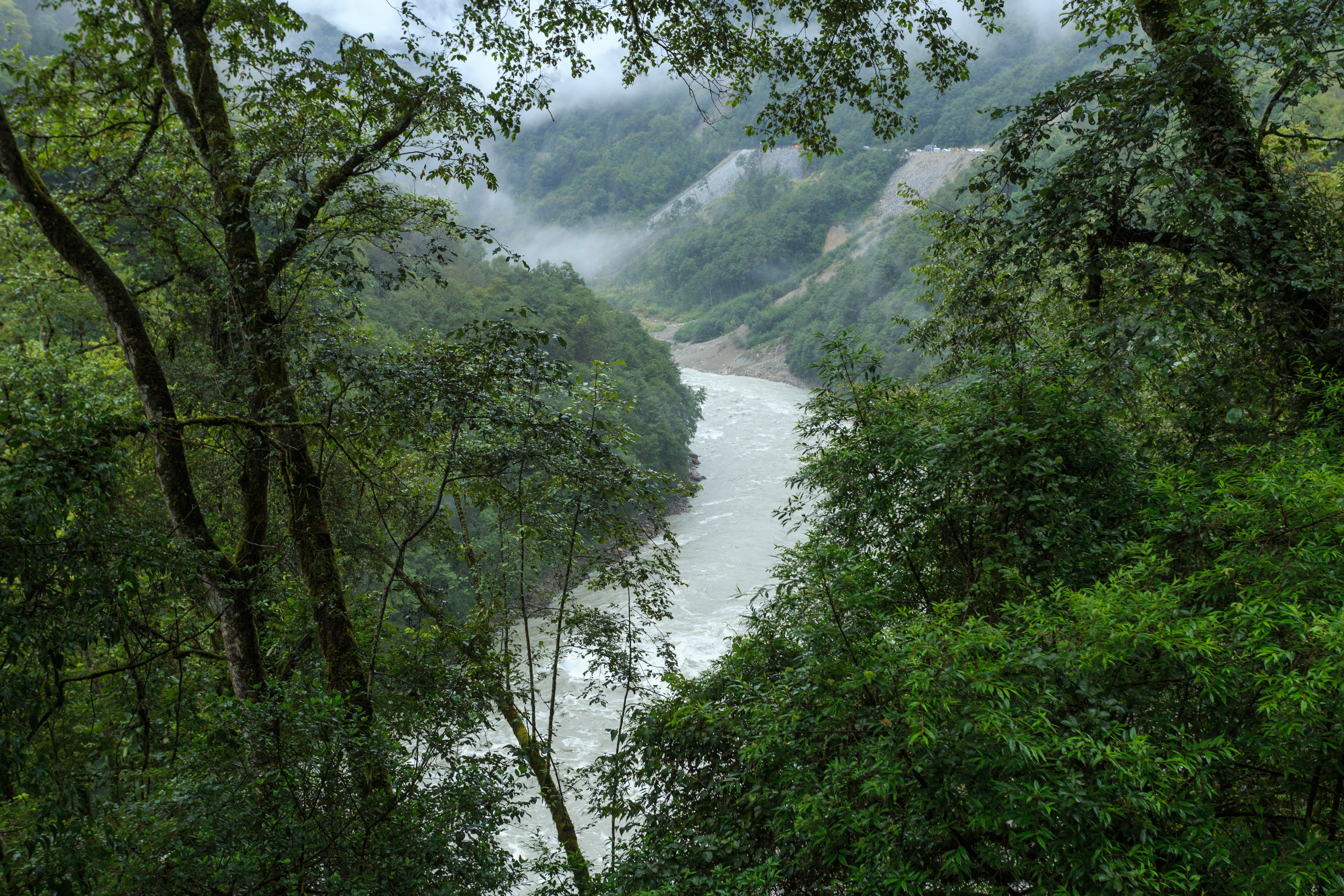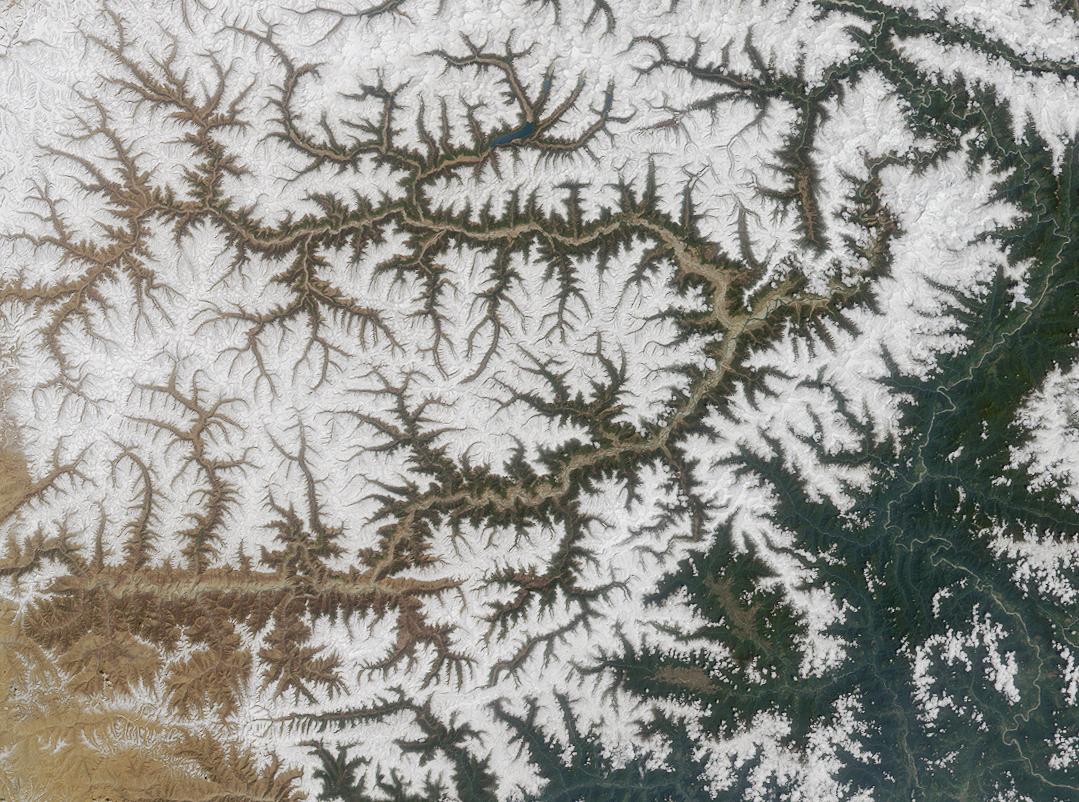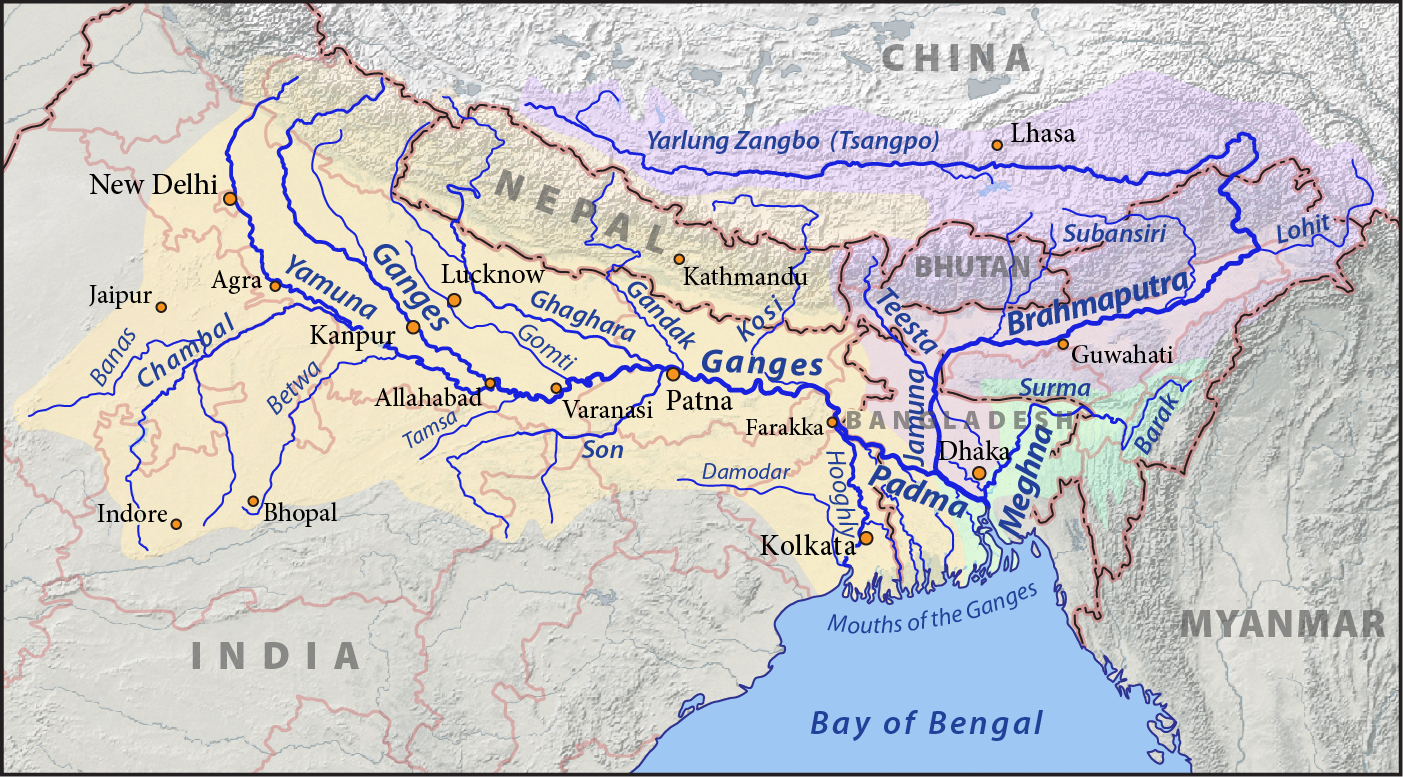|
Kangri Karpo
Kangri Karpo (), also spelt Gangri Garbo (), is a mountain range in eastern Tibet, located primarily in Nyingchi Prefecture as well as a portion of Qamdo Prefecture in the Tibet Autonomous Region, China. The mountain range lies to the east of the Himalayas and to the west of the Hengduan Mountains. The mountains are geographically a southern extension of the eastern Transhimalayas. Physical geography and climate The Kangri Karpo stretch for approximately from west to east. They lie at the eastern end of the Himalayan Range and were formed at the same time during the Indian subcontinent's collision with Eurasia. The Kangri Karpo are geologically related to the Himalayas, but are separated by the Yarlung Tsangpo's Grand Canyon. The eastern anchor of the Himalayas, Namcha Barwa, rises above the western Kangri Karpo just beyond the Yarlung Tsangpo. To the north, the Kangri Karpo are separated from the Nyenchen Tanglha by the Parlung Tsangpo River. To the northeast, the Kangri K ... [...More Info...] [...Related Items...] OR: [Wikipedia] [Google] [Baidu] |
Rawu
Rawu (), also known as Ravu or Rawok, is a town in Pasho County, Chamdo Prefecture, within the Tibet Autonomous Region of China. It sits at an altitude of about . Located along the Rakwa Tso, the town hosts a growing tourism industry. The modern town is built beside an older village of the same name. Per the 2010 Chinese Census, Rawu has a population of 4,335. History The Sichuan-Tibet portion of China National Highway 318 was constructed in the area during the 1950s, and was extended in the 1960s. Geography The town of Rawu is quite close to the original Tibetan village. To the southeast of the village is a large chorten and a small temple overlooking the Rakwa Tso (also known as Ngan-tso, or Rawu Lake), which is surrounded by snow-capped peaks and forests. The lake is about from the town. It is , and consists of two sections connected by a small stream. There are small villages on both shores. Demographics Per the 2010 Chinese Census, Rawu has a population of 4,335, u ... [...More Info...] [...Related Items...] OR: [Wikipedia] [Google] [Baidu] |
Transhimalayas
The Trans himalaya (also spelled Trans-Himalaya), or "Gangdise – Nyenchen Tanglha range" ( zh, s=冈底斯-念青唐古拉山脉, p=Gāngdǐsī-Niànqīngtánggǔlā Shānmài), is a mountain range in China, India and Nepal, extending in a west–east direction parallel to the main Himalayan range. Located north of Yarlung Tsangpo river on the southern edge of the Tibetan Plateau, the Transhimalaya is composed of the Gangdise range to the west and the Nyenchen Tanglha range to the east. The name ''Transhimalaya'' was introduced by the Swedish geographer Sven Hedin in early 20th century. The Transhimalaya was described by the ''Columbia Lippincott Gazetteer'' in 1952 as an "ill-defined mountain area" with "no marked crest line or central alignment and no division by rivers." On more-modern maps the Kailas Range (Gangdise or Kang-to-sé Shan) in the west is shown as distinct from the Nyenchen Tanglha range in the east. Geology The Transhimalayas are geologically distinct f ... [...More Info...] [...Related Items...] OR: [Wikipedia] [Google] [Baidu] |
Tibetan Plateau
The Tibetan Plateau, also known as the Qinghai–Tibet Plateau or Qingzang Plateau, is a vast elevated plateau located at the intersection of Central Asia, Central, South Asia, South, and East Asia. Geographically, it is located to the north of Himalayas and the Indian subcontinent, and to the south of Tarim Basin and Mongolian Plateau. Geopolitically, it covers most of the Tibet Autonomous Region, most of Qinghai, western half of Sichuan, Southern Gansu provinces, southern Xinjiang province in Western China, Bhutan, the Administrative divisions of India, Indian regions of Ladakh and Lahaul and Spiti district, Lahaul and Spiti (Himachal Pradesh) as well as Gilgit-Baltistan in Pakistan, northwestern Nepal, eastern Tajikistan and southern Kyrgyzstan. It stretches approximately north to south and east to west. It is the world's highest and largest plateau above sea level, with an area of . With an average elevation exceeding and being surrounded by imposing mountain ranges that har ... [...More Info...] [...Related Items...] OR: [Wikipedia] [Google] [Baidu] |
South Asian Monsoon
The Monsoon of South Asia is among several geographically distributed global monsoons. It affects the Indian subcontinent, where it is one of the oldest and most anticipated weather phenomena and an economically important pattern every year from June through September, but it is only partly understood and notoriously difficult to predict. Several theories have been proposed to explain the origin, process, strength, variability, distribution, and general vagaries of the monsoon, but understanding and predictability are still evolving. The unique geographical features of the Indian subcontinent, along with associated atmospheric, oceanic, and geographical factors, influence the behavior of the monsoon. Because of its effect on agriculture, on flora and fauna, and on the climates of nations such as Bangladesh, Bhutan, India, Nepal, Pakistan, and Sri Lanka – among other economic, social, and environmental effects – the monsoon is one of the most anticipated, tracked, and studi ... [...More Info...] [...Related Items...] OR: [Wikipedia] [Google] [Baidu] |
Mishmi Hills
The Mishmi Hills are located at the northeastern tip of India, in northeastern Arunachal Pradesh. On the Chinese side, they form the southern parts of Nyingchi Prefecture in the Tibet Autonomous Region. These hills occur at the junction of Northeastern Himalaya and Indo-Burma ranges. The Himalayan arc takes a sharp turn and meets Indo-Burma ranges. The rocks of eastern lesser Himalaya and the central crystallines appear to be largely attenuated and truncated in Mishmi Hills. Geography Geomorphically, the Mishmi Hills are divided into 2 sections the flood plains of tributaries of Brahmaputra river and the Arunachal Himalayas consisting of snow-capped mountains, lower Himalayan ranges, and Shivalik ranges. The Hills reach heights above but have not been properly mapped. This hilly area is characterised by steeply sloping landform, sub-tropical evergreen forest and high rainfall. The central part of the Hills wrap around both sides of the Dibang Valley. The Mishmi Hills are ... [...More Info...] [...Related Items...] OR: [Wikipedia] [Google] [Baidu] |
India
India, officially the Republic of India, is a country in South Asia. It is the List of countries and dependencies by area, seventh-largest country by area; the List of countries by population (United Nations), most populous country since 2023; and, since its independence in 1947, the world's most populous democracy. Bounded by the Indian Ocean on the south, the Arabian Sea on the southwest, and the Bay of Bengal on the southeast, it shares land borders with Pakistan to the west; China, Nepal, and Bhutan to the north; and Bangladesh and Myanmar to the east. In the Indian Ocean, India is near Sri Lanka and the Maldives; its Andaman and Nicobar Islands share a maritime border with Thailand, Myanmar, and Indonesia. Modern humans arrived on the Indian subcontinent from Africa no later than 55,000 years ago., "Y-Chromosome and Mt-DNA data support the colonization of South Asia by modern humans originating in Africa. ... Coalescence dates for most non-European populations averag ... [...More Info...] [...Related Items...] OR: [Wikipedia] [Google] [Baidu] |
Zayü River
The Lohit River, whose name came from the Assamese word ''Lohit'' meaning 'blood', also known as the Zayul Chu by the Tibetans, Tilao by the Ahoms and Tellu by the Mishmis, is a river in China and India, which joins the Brahmaputra River in the state of Assam. It is formed in the Zayul County of the Tibet Autonomous Region, through a merger of two rivers: the Kangri Karpo Chu (also called Rongto Chu and Zayul Ngu Chu), which originates in the Kangri Karpo range, and Zayul Chu (), which originates to its northeast. The two rivers merge below the town of Rima. The combined river descends through this mountainous region and surges through Arunachal Pradesh in India for before entering the plains of Assam where it is known as the Lohit River. Tempestuous and turbulent, and known as the river of blood partly attributable to the lateritic soil, it flows through the Mishmi Hills, to meet the Siang (Brahmaputra) at the head of the Brahmaputra valley. Course Thickly f ... [...More Info...] [...Related Items...] OR: [Wikipedia] [Google] [Baidu] |
Parlung Tsangpo
Parlung Tsangpo or Parlung Zangbo (; ), also known as Palongzangbu River, is a river in Nyingchi, Tibet, China. It is the largest tributary on the left side of Yarlung Tsangpo. Its source is the Arza Gongla Glacier, at an elevation of 4900m. It first flows north into Ngagung Tso, then turn northwest to Rakwa Tso Rakwa Tso (; ), also known as Rawu Tso or Ranwu Lake, is a lake in Baxoi County, Chamdo Prefecture, Tibet Autonomous Region, China, to the north of Arza Gongla Glacier, and to the south of Ngagung Tso. The lake covers an area of , and has an e .... It joins Yarlung Tsangpo near Bomê. The total length of Parlung Tsangpo is 266 km, and the drop of elevation is 3360m. The drainage basin covers an area of 23,800 square kilometers. The lower part of Parlung flows through the Parlung Tsangpo Valley, which is among the deepest in the world. References Rivers of Tibet Tributaries of the Brahmaputra River {{China-river-stub ... [...More Info...] [...Related Items...] OR: [Wikipedia] [Google] [Baidu] |
Nyenchen Tanglha
The Nyenchen Tanglha Mountains (officially spelt Nyainqêntanglha Mountains in Chinese) are a long mountain range, and subrange of the Transhimalaya System, located in Tibet and the Tibet Autonomous Region of China. Geography One source says the Nyenchen Tanglha Mountains range is about in length. Its highest point is located to the northwest of Lhasa. The range is parallel to the Himalayas in the Transhimalayas, and north of the Yarlung Tsangpo River. Another source says the Nyenchen Tanglha Mountains extend from Nyêmo County in the west to Ranwu County (the southwestern part of Baxoi County) in the east. Its highest peak is Mount Nyenchen Tanglha (''Nyainqêntanglha Feng'') at . The southern side of the Nyenchen Tanglha Mountains is precipitous, and falls by around , while the northern side is fairly level and descends about . Most of the mountains are below . They contain 7080 glaciers covering an area of . The Nyenchen Tanglha Mountains have an average latitud ... [...More Info...] [...Related Items...] OR: [Wikipedia] [Google] [Baidu] |
Namcha Barwa
Namcha Barwa or Namchabarwa (; Chinese: 南迦巴瓦峰, Pinyin: ''Nánjiābāwǎ Fēng'') is a mountain peak lying in Tibet in the region of Pemako. The traditional definition of the Himalaya extending from the Indus River to the Brahmaputra would make it the eastern anchor of the entire mountain chain, and it is the highest peak of its own section as well as Earth's easternmost peak over . It lies in the Nyingchi Prefecture of Tibet. It is the highest peak in the 180 km long Namcha Barwa Himal range (also called the Namjagbarwa syntaxis or Namjagbarwa Group Complex), which is considered the easternmost syntaxis/section of the Himalaya in southeastern Tibet and northeastern India where the Himalaya are said to end, although high ranges (Hengduan Mountains on the China–Myanmar border) actually continue another 300 km to the east. Location Namcha Barwa is in an isolated part of southeastern Tibet rarely visited by outsiders. It stands inside the ''Great Bend'' o ... [...More Info...] [...Related Items...] OR: [Wikipedia] [Google] [Baidu] |
Yarlung Tsangpo Grand Canyon
The Yarlung Tsangpo Grand Canyon, also known as the Yarlung Zangbo Grand Canyon, the Tsangpo Canyon, the Brahmaputra Canyon or the Tsangpo Gorge (), is a canyon along the Yarlung Tsangpo River in Tibet Autonomous Region, China. It is the deepest canyon in the world, and at is slightly longer than the Grand Canyon in the United States, making it one of the world's largest. The Yarlung Tsangpo (Tibetan name for the upper course of the Brahmaputra) originates near Mount Kailash and runs east for about , draining a northern section of the Himalayas before it enters the gorge just downstream of Pei, Tibet, near the settlement of Zhibe. The canyon has a length of about as the gorge bends around Mount Namcha Barwa () and cuts its way through the eastern Himalayas. Its waters drop from about near Pei to about at the end of the Upper Gorge where the Po Tsangpo River enters. The river continues through the Lower Gorge to the Indian border at an elevation of . The river then enters Ar ... [...More Info...] [...Related Items...] OR: [Wikipedia] [Google] [Baidu] |






